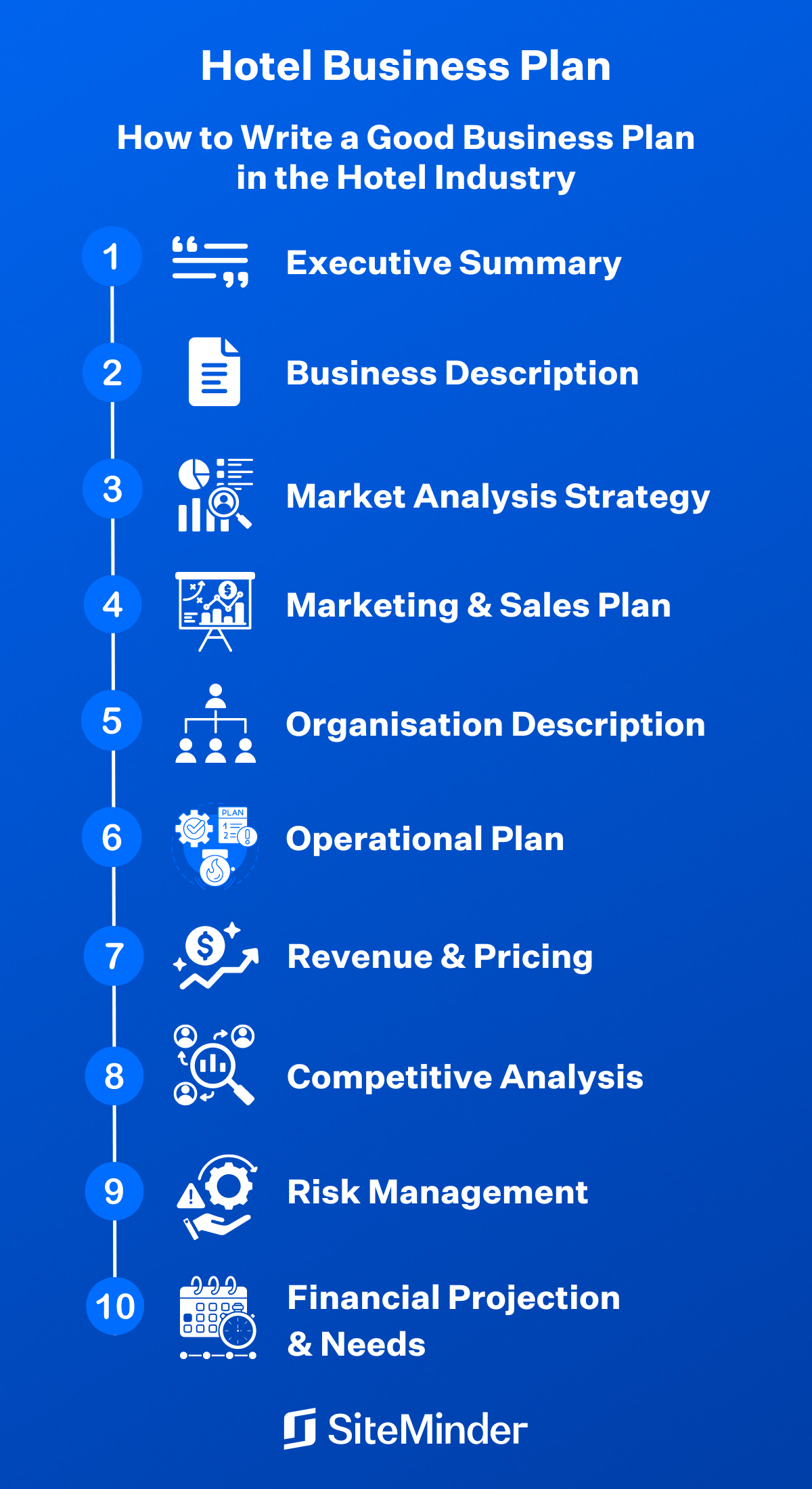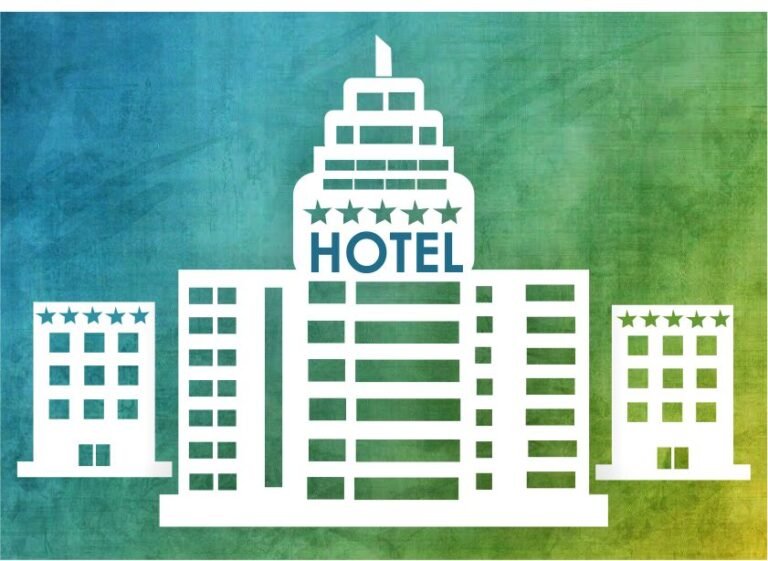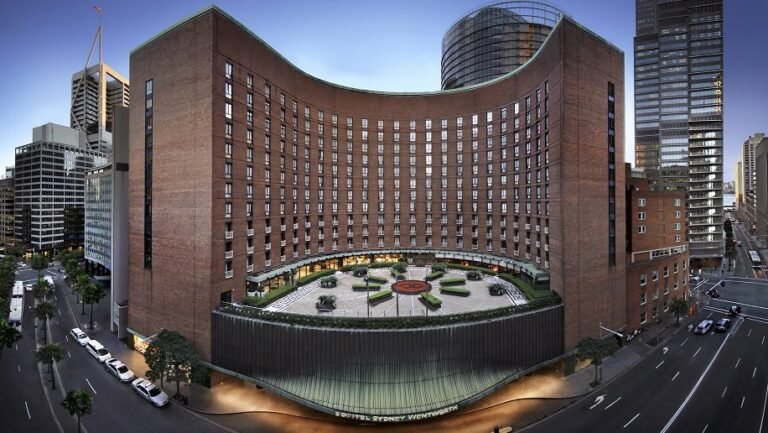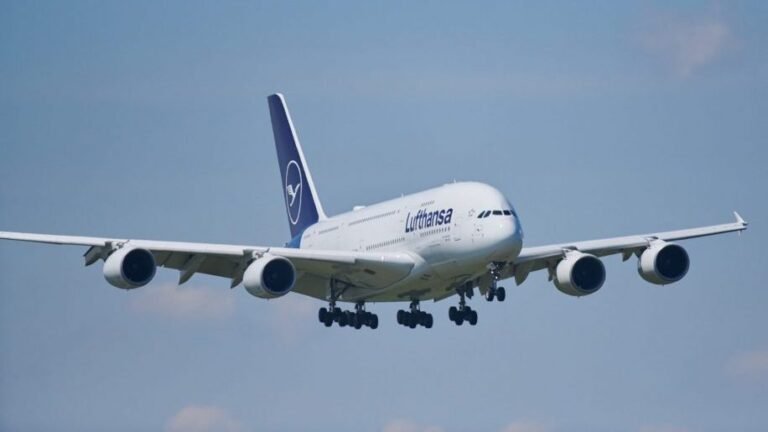How to write a hotel business plan
What is a hotel business plan?
A hotel business plan is a comprehensive document that outlines your hotel’s goals, strategies, and financial projections. It serves as a roadmap for your hotel’s success, helping you attract investors, secure funding, and make informed decisions about your operations.
It’s a vital tool for any hotel owner or operator, whether you’re starting a new hotel, expanding an existing business, or improving your current operations.
This blog will give you a comprehensive guide to creating a business plan for your hotel.
Why do you need a good hotel business plan?
A well-crafted hotel business plan is essential for laying the foundation for success in the competitive hospitality industry. It serves as a single source of truth, helping you navigate the challenges and opportunities that come with running a hotel.
- A business plan helps you attract investors who see the potential in your vision, secure funding from lenders who believe in your financial projections, and make informed decisions that guide your operations towards profitability.
- It clarifies your marketing efforts by enabling you to pinpoint your target audience and craft effective campaigns to reach them.
- A solid business plan equips you to differentiate your hotel in a crowded market by highlighting your unique selling propositions.
- It ensures that your day-to-day operations are efficient and effective, maximising resource utilisation.
- A well-defined business plan helps you identify opportunities for growth, allowing you to plan for expansion and ensure the long-term success of your hotel.
Execute your hotel business plan with SiteMinder
Stop struggling with manual processes and outdated technology. SiteMinder’s platform empowers you to execute your hotel business plan seamlessly and drive revenue growth.

How to write a hotel business plan
Every hotel is unique, and so every plan is unique. That said, there are a few consistent parts that make up the greater whole of a holistic hotel business plan:
Executive summary
The executive summary is a concise overview of your hotel business plan, outlining your key goals, strategies, and financial projections. It should be written last, after the other sections are complete, and should be easy to understand for anyone reading it.
Here’s what to include in your executive summary:
- Hotel concept: Briefly describe your hotel’s unique features, target market, and overall vision.
- Key goals: State your main objectives, such as increasing occupancy rates, boosting revenue, or expanding your hotel chain.
- Marketing strategy: Highlight your key marketing initiatives, such as online advertising, social media engagement, or partnerships with travel agencies.
- Financial projections: Summarise your projected revenue, expenses, and profitability over the next 3-5 years.
- Funding requirements: Outline your financing needs, whether it’s bank loans, investors, or personal funds.
Business description
This section describes your hotel’s concept, including its location, target audience, unique selling propositions, and overall vision.
Here are some key points to cover in your business description:
- Hotel name and brand: Establish your hotel’s identity and branding.
- Location: Describe your hotel’s location, including its proximity to attractions, transportation, and amenities.
- Target market: Define your ideal guest profile, including their demographics, interests, and travel habits.
- Unique selling propositions (USPs): Identify the key features and benefits that set your hotel apart from competitors. This might include unique amenities, services, or a distinctive atmosphere.
- Hotel concept and vision: Clearly articulate your hotel’s overall vision and the experience you want to provide for guests.
- Hotel facilities and amenities: Detail your hotel’s facilities and amenities, including the number of rooms, room types, dining options, meeting rooms, and leisure activities.
Market analysis and strategy
Hotel business plans are often built on the foundation of market analysis – it’s hard to plan for what you don’t know – so this will likely take up a good chunk of your resources. Your marketing strategy should outline:
- Positioning: How you want to be perceived in the market compared to your competitors.
- Target audience: Who are you trying to reach with your marketing efforts?
- Marketing channels: Which channels will you use to reach your target audience? (e.g., online advertising, social media, email marketing, partnerships, events)
- Marketing messages: What key messages will you communicate to your target audience?
- Budget and metrics: How much will you invest in marketing and how will you measure the effectiveness of your campaigns?
In terms of specifics, make sure to include:
- Market size and growth: Assess the potential demand for hotel rooms in your area. Research the current and projected demand for hotels in your location, taking into account factors such as population growth, tourism trends, and economic activity.
- Competition: Analyse your competitors, their strengths, and weaknesses. Research your direct competitors and indirect competitors (e.g., other lodging options like vacation rentals, hostels, or bed & breakfasts). Assess their pricing, services, marketing strategies, and customer reviews.
- Target audience: Define your ideal guest profile, including their demographics, interests, and travel habits. This might include travellers’ age, income, travel purpose (leisure, business, family), interests, and preferences for specific amenities or services.
- Market trends: Stay abreast of current travel trends and adapt your strategies accordingly. Research emerging travel trends, such as sustainable tourism, experiential travel, or the growing demand for wellness amenities.

Marketing and sales plan
You’ve set the scene, now let’s start the production. This section should show investors and lenders that you have a comprehensive and effective plan for attracting guests and driving revenue. In this section, you’ll outline your marketing and sales strategies, including:
- Online marketing: How you will develop a website, social media strategy, and search engine optimisation (SEO) plan.
- Offline marketing: How you will explore traditional marketing channels, such as brochures, partnerships with local businesses, and events.
- Sales channels: How you will determine your distribution strategy, whether it’s direct bookings, online travel agents (OTAs), or a combination of both.
- Pricing strategy: How you will set competitive room rates and consider implementing revenue management strategies to maximise occupancy and revenue.
Organisation description
This section provides details about your hotel’s ownership structure, management team, and any key personnel.
Here’s what to include:
- Ownership structure: Describe the legal structure of your hotel (e.g., sole proprietorship, partnership, limited liability company, corporation) and who owns the business.
- Management team: Introduce the key members of your management team, outlining their experience, expertise, and roles within the hotel.
- Key personnel: List any other essential personnel, such as the general manager, head chef, head of housekeeping, and sales manager.
- Advisory board (optional): If you have a board of advisors, introduce them and highlight their expertise and contributions.
Operational plan
The operational plan is another chunky piece of your business plan, as it describes the overall day to day operations of your business. The two most significant sections of your operational plan tend to be:
1. Management & staffing
Describe your management structure, staffing requirements, and any training plans.
Here are some key points to cover:
- Management structure: Illustrate how your management team is organised, including their reporting relationships and responsibilities.
- Staffing requirements: Determine the number of staff needed for each department (front desk, housekeeping, maintenance, food and beverage, etc.), based on your projected occupancy and service levels.
- Staff training: Outline your training plans for new staff members and existing employees, ensuring they are equipped with the skills and knowledge to provide excellent guest service.
2. Budget
Here, you should outline your hotel’s expected expenses, including staffing costs, utilities, maintenance, marketing, and other operational expenses.
When creating your budget, consider the following:
- Fixed costs: Expenses that remain relatively constant, such as rent, utilities, insurance, and salaries.
- Variable costs: Expenses that fluctuate based on occupancy or usage, such as supplies, linen, cleaning products, and food and beverage costs.
- Marketing and advertising: Allocate a budget for marketing activities to attract guests and promote your hotel.
- Contingency funds: Set aside funds for unexpected events or emergencies.
- Financial projections: Use your budget to create financial projections, including projected revenue, expenses, and profitability over the next 3-5 years.
A well-structured budget demonstrates to investors and lenders that you have a clear understanding of your costs and financial viability.
Revenue and pricing
Now we’re onto the good bit! Here’s where you’ll project your hotel’s revenue streams, including room revenue, food and beverage sales, and other ancillary revenue sources. This is your chance to explain your pricing strategy and how you’ll ensure your hotel’s financial viability.
Here’s what to include in your revenue and pricing section:
- Revenue streams: Identify all potential revenue sources, such as room nights, food and beverage sales, meeting room rentals, spa treatments, and laundry services.
- Pricing strategy: Explain your approach to setting room rates, including factors like market competition, seasonality, and value-added services.
- Revenue projections: Estimate your projected revenue for each revenue stream based on your occupancy forecasts and average revenue per available room (RevPAR).
- Break-even analysis: Calculate the point at which your hotel will start to generate a profit.
This section provides insights into your hotel’s earning potential and ensures investors and lenders are confident in your financial planning.
Competitive analysis
This is a deeper dive into your earlier research section, where you uncovered your place in the market. Here you’ll compare your hotel’s offerings and strategies to those of your competitors, and identify your unique selling propositions and how you can differentiate your hotel to attract guests.
Here’s how to conduct a comprehensive competitive analysis section of your business plan:
- Identify your competitors: Research your direct competitors (hotels in the same market segment) and indirect competitors (other lodging options, such as vacation rentals, hostels, or bed & breakfasts).
- Outline their strengths and weaknesses: Evaluate their offerings, pricing, location, amenities, marketing, customer service, and online reputation.
- Describe your unique selling propositions (USPs): Determine what makes your hotel stand out from the competition. This might include unique amenities, services, or a distinctive atmosphere.
- Outline your competitive advantage: How you will use your USPs to create a clear competitive advantage and attract your target audience.
- Monitor your competitors: Explain how you will keep track of your competitors’ activities, promotions, and changes in strategy to stay ahead of the curve.
Risk management
What’s life without a little risk? In this part of your plan, you’ll identify potential risks that could affect your hotel’s success, such as economic downturns, changes in travel patterns, or competition. But don’t forget to outline your mitigation strategies, and how you will minimise the impact of these risks.
Here’s a framework for identifying and managing risks:
- Outline potential risks: Call out the potential risks that could negatively impact your hotel, including economic factors, natural disasters, industry trends, competition, regulatory changes, and technological disruptions.
- Assess the probability and impact of each risk: Determine the likelihood of each risk occurring and the potential impact it would have on your business.
- Outline mitigation strategies: For each risk, create a plan to minimise its impact and succinctly describe it in your plan. This might involve contingency plans, insurance policies, proactive marketing strategies, or partnerships with other businesses.
- Mention how you will monitor and update your risk management plan: Explain how you will regularly review and update your risk management plan as circumstances change or new risks emerge.
A well-defined risk management plan demonstrates your preparedness and ability to navigate challenges, providing confidence to investors and lenders.
Financial projection and needs
And here’s the kicker. In this section, you’ll provide detailed financial projections, including projected revenue, expenses, and profitability for the next 3-5 years. Outline your funding requirements, such as bank loans, investors, or personal funds. This section is especially important if you’re seeking a capital raise or additional investment from third parties.
Your financial projections should include:
- Income statement: Project your hotel’s revenue and expenses for each year over the next 3-5 years.
- Cash flow statement: Forecast your hotel’s cash inflows and outflows, ensuring you have enough cash on hand to meet your operating expenses and debt obligations.
- Balance sheet: Project your hotel’s assets, liabilities, and equity for each year.
- Break-even analysis: Determine the point at which your hotel will start to generate a profit.
This section provides a clear picture of your hotel’s financial viability, helping to attract investors and secure funding.
Technology integration
In today’s digital world, technology is essential for hotel success. Your plan must include how you plan to integrate technology to streamline operations, enhance guest experiences, and boost revenue.
Here are some key area you may want to mention:
- Property management systems (PMS): What PMS are you using to manage bookings, guest information, room inventory, and financial transactions?
- Channel management systems: How are you connecting your hotel to various online travel agents (OTAs) and global distribution systems (GDS) to maximise your reach?
- Revenue management software: Which revenue management tools are you using to analyse demand, adjust pricing, and optimise revenue?
- Guest relationship management (CRM): How are you implementing a CRM to track guest preferences, manage communication, and personalise experiences?
- Digital marketing platforms: Which digital marketing tools are you using to target your ideal guests with online advertising, social media marketing, and email campaigns?
- Mobile apps: Are you developing or integrating with a mobile app to provide guests with access to hotel information, amenities, and services?
- Smart technology: What smart devices (e.g., smart locks, voice assistants, automated lighting) are you investing in to enhance guest convenience and efficiency?
This section shows investors and lenders that you understand the importance of technology in the hospitality industry and that you plan to leverage it to improve operations and enhance guest satisfaction.
Hotel business plan examples
What should you aim for at the end of a hotel business planning session? Every hotel is different and so the plans will all be unique, but here are a few (shortened!) examples of what a business plan in different hotel niches might look like.
Pet hotel business plan
1. Executive summary
- Concept: “Pawsitively Pampered” is a luxury pet hotel and boarding facility, offering a safe, comfortable, and enriching experience for pets.
- Target market: dog and cat owners in [city, state] seeking high-quality pet care with personalised attention and a wide range of amenities.
- Key goal: achieve 80% occupancy within the first year, expand services to include daycare and grooming within two years.
- Marketing: focus on online advertising, partnerships with local vets, and social media engagement showcasing personalised care.
- Financial: project $x in revenue annually with a net profit margin of y% within the first year, secure $z in financing to cover initial setup costs.
2. Business description
- Name & brand: Pawsitively Pampered, emphasising luxury, care, and personalization.
- Location: [address, city, state], a convenient location near major roadways and vet clinics.
- Target audience: dog and cat owners who prioritise their pet’s well-being and are willing to pay for high-quality care, including those who travel frequently, have busy lifestyles, or want their pets to be socialised.
- USP: spacious accommodations, personalised care plans, enrichment activities (playtime, socialisation, training), live webcams for owners, and optional grooming services.
- Vision: to be the premier pet hotel in [city, state], providing a safe, enriching, and enjoyable experience for pets.
- Facilities: multiple suites with varying sizes, indoor/outdoor play areas, designated cat areas, on-site grooming salon, and a designated staff area for pet care and monitoring.
3. Market analysis & strategy
- Market size & growth: [city, state] has a growing pet population, with [statistics on pet ownership and pet care spending].
- Competition: [list of pet hotels in the area] with a focus on their pricing, services, and target market. highlight Pawsitively Pampered’s competitive advantages.
- Target audience: [demographics, pet ownership patterns, pet care preferences, willingness to spend on premium services].
- Trends: growth in pet humanisation, increasing demand for personalised care, pet enrichment programs, and mobile technology for pet monitoring.
4. Marketing & sales
- Online: professional website with booking system, social media presence showcasing happy pets, testimonials, and behind-the-scenes glimpses of care.
- Offline: partner with local vet clinics, groomers, and pet stores for referrals, flyers, and brochures. attend local pet events and participate in community activities.
- Sales: direct bookings through website, partnership with pet travel agencies, and potential future offerings of daycare and grooming services.
- Pricing: offer tiered pricing based on room size, pet type, and length of stay, with premium packages for personalised services and extra playtime.
5. Organisation
- Ownership: [owner name], [background and experience with pet care].
- Management: [owner], [staffing manager with experience in animal care and management].
- Personnel: experienced and certified pet care professionals, with training in animal handling, first aid, and enrichment activities.
6. Operational plan
- Management structure: [owner], [staffing manager], with clear roles and responsibilities.
- Staffing: [number of staff] based on projected occupancy, with a focus on hiring caring and experienced pet professionals.
- Training: ongoing training for staff in animal care, handling, first aid, and pet enrichment activities.
- Budget: [projected expenses for staff salaries, utilities, supplies, marketing, and other operational costs].
7. Revenue & pricing
- Revenue streams: Boarding fees, daycare fees (future), grooming fees (future), potential retail sales of pet supplies.
- Pricing strategy: competitive pricing based on market analysis, with tiered packages offering different levels of service and enrichment.
- Financial projections: [projected revenue, expenses, and profitability for the next 3-5 years based on occupancy, pricing, and operating costs].
8. Competitive analysis
- Comparison: compare Pawsitively Pampered’s offerings to those of competitors, highlighting key differentiators in services, amenities, and pricing.
- Usp: emphasis on personalised care, enrichment activities, and a “home-away-from-home” atmosphere for pets.
- Competitive advantage: offering a premium pet care experience tailored to individual pets’ needs and preferences.
9. Risk management
- Risks: economic downturns, changes in pet ownership trends, competition, pet health issues, and potential for negative online reviews.
- Mitigation: contingency plans for economic downturns, proactive marketing to attract new clients, strong focus on pet safety and health, response protocols for negative reviews.
10. financial projections & funding
- Financial projections: [projected revenue, expenses, and profitability for the next 3-5 years].
- Funding: [amount of financing required] for initial setup costs, including renovations, equipment, marketing, and working capital.
Boutique hotel business plan
1. Executive summary
- Concept: “The Urban Retreat” is a chic, boutique hotel in the heart of [city, state], offering a sophisticated and personalised experience for discerning travellers.
- Target market: travellers seeking stylish and unique accommodations, personalised service, and a curated experience in a vibrant city location.
- Key goal: achieve 75% occupancy within the first year, expand to include a rooftop bar and restaurant within two years.
- Marketing: focus on online booking platforms, social media showcasing the hotel’s design and ambiance, and partnerships with local businesses.
- Financial: project $x in revenue annually with a net profit margin of y% within the first year, secure $z in financing for initial setup and renovations.
2. Business description
- Name & brand: “The Urban Retreat,” conveying a sense of relaxation and sophistication within a vibrant urban setting.
- Location: [address, city, state], a trendy neighbourhood with proximity to arts, culture, and nightlife.
- Target audience: discerning travellers, business professionals, and couples seeking unique and stylish accommodations, personalised service, and a curated experience.
- USP: modern design with locally sourced art, cosy and comfortable rooms, a focus on local experiences (restaurant recommendations, hidden gems), and personalised concierge services.
- Vision: to be the premier boutique hotel in [city, state], providing a sophisticated and unforgettable experience for discerning travellers.
- Facilities: [number of rooms] with unique and eclectic design, a cosy lounge area with a curated library, a rooftop bar with panoramic city views, and a small, intimate restaurant serving seasonal cuisine.
3. Market analysis & strategy
- Market size & growth: [city, state] has a thriving tourism industry with increasing demand for boutique hotels and unique experiences.
- Competition: [list of boutique hotels in the area] with a focus on their pricing, services, and target market. highlight The Urban Retreat’s competitive advantages.
- Target audience: [demographics, travel habits, preferences for boutique hotels, willingness to pay for unique experiences].
- Trends: growing demand for unique experiences, personalised service, locally sourced food and beverages, and sustainable practices in hospitality.
4. Marketing & sales
- Online: high-quality website with stunning photography showcasing the hotel’s design, professional booking engine, and social media presence with regular updates on events, special offers, and local recommendations.
- Offline: partner with local businesses, art galleries, and event organisers to offer packages and promotions. collaborate with travel bloggers and influencers to showcase the hotel experience.
- Sales: direct bookings through the website, partnerships with online travel agents, and potential participation in travel industry events.
- Pricing: competitive pricing based on market analysis, with premium pricing for suites and unique experiences.
5. Organisation
- Ownership: [owner name], [background and experience in hospitality and design].
- Management: [owner], [general manager with experience in boutique hotels and guest relations].
- Personnel: staff with a passion for hospitality, knowledge of local attractions, and a focus on providing personalised service.
6. Operational plan
- Management structure: [owner], [general manager], [head chef], [concierge], with clear roles and responsibilities.
- Staffing: [number of staff] based on projected occupancy, with a focus on hiring friendly and knowledgeable staff.
- Training: ongoing training for staff in guest service, local area knowledge, and bespoke service.
- Budget: [projected expenses for staff salaries, utilities, supplies, marketing, and other operational costs].
7. Revenue & pricing
- Revenue streams: room revenue, restaurant revenue, bar revenue, and potential event space revenue.
- Pricing strategy: competitive pricing based on market analysis, with premium pricing for suites, special packages, and curated experiences.
- Financial projections: [projected revenue, expenses, and profitability for the next 3-5 years based on occupancy, pricing, and operating costs].
8. Competitive analysis
- Comparison: compare The Urban Retreat’s offerings to those of competitors, highlighting key differentiators in design, atmosphere, amenities, and pricing.
- USP: modern design, local experiences, personalised service, and curated events.
- Competitive advantage: offering a unique and stylish hotel experience for discerning travellers seeking a sense of discovery and connection with the local culture.
9. Risk management
- Risks: economic downturns, changes in travel patterns, competition, seasonality, and negative online reviews.
- Mitigation: contingency plans for economic downturns, proactive marketing to attract new clients, strong focus on guest satisfaction and positive online reviews, and strategic partnerships with local businesses to offer unique experiences.
10. Financial projections & funding
- Financial projections: [projected revenue, expenses, and profitability for the next 3-5 years].
- Funding: [amount of financing required] for initial setup costs, including renovations, furniture, equipment, marketing, and working capital.
Luxury hotel business plan
1. Executive summary
- Concept: “The Grand Vista” is a luxury hotel located in [city, state], offering unparalleled comfort, service, and exclusivity for discerning guests.
- Target market: wealthy travellers, business executives, and discerning individuals seeking the ultimate in luxury, privacy, and personalised experiences.
- Key goal: achieve 60% occupancy within the first year, expand to include a world-class spa and private dining experiences within two years.
- Marketing: focus on high-end travel agencies, online luxury travel platforms, exclusive partnerships, and personalised marketing to affluent clientele.
- Financial: project $x in revenue annually with a net profit margin of y% within the first year, secure $z in financing for initial setup, renovations, and luxury amenities.
2. Business description
- Name & brand: “The Grand Vista,” conveying a sense of grandeur, exclusivity, and breathtaking views.
- Location: [address, city, state], a prestigious location with panoramic views, close to upscale shopping, dining, and cultural attractions.
- Target audience: affluent travellers seeking privacy, personalised service, bespoke experiences, and a sense of exclusivity.
- USP: opulent rooms and suites with personalised amenities, a dedicated concierge team offering bespoke services, private dining experiences, and a focus on unparalleled privacy and comfort.
- Vision: to be the ultimate luxury destination in [city, state], providing an unparalleled experience for discerning guests seeking sophistication, comfort, and personalised service.
- Facilities: [number of rooms] with luxurious appointments, including butler service, private terraces, state-of-the-art technology, and bespoke amenities. exclusive restaurant with award-winning cuisine, a fully-equipped spa, a fitness centre, and a rooftop pool with stunning city views.
3. Market analysis & strategy
- Market size & growth: [city, state] attracts a significant number of affluent travellers, with a growing demand for luxury hotels and bespoke experiences.
- Competition: [list of luxury hotels in the area] with a focus on their pricing, services, and target market. highlight The Grand Vista’s competitive advantages.
- Target audience: [demographics, travel habits, preferences for luxury hotels, willingness to pay for exceptional experiences].
- Trends: growing demand for personalised service, curated experiences, exclusive access, and sustainability in luxury travel.
4. Marketing & sales
- Online: luxurious website with high-quality photography showcasing the hotel’s opulent design, a dedicated concierge section for booking bespoke experiences, and a presence on luxury travel platforms.
- Offline: partnerships with high-end travel agencies, participation in luxury travel industry events, and exclusive marketing campaigns targeted to affluent clientele.
- Sales: direct bookings through the website, partnerships with luxury travel agencies, and a dedicated team handling bespoke requests from discerning guests.
- Pricing: premium pricing based on market analysis, with personalised packages offering curated experiences, exclusive amenities, and tailored services.
5. Organisation
- Ownership: [owner name], [background and experience in luxury hospitality and management].
- Management: [owner], [general manager with extensive experience in luxury hotel management and guest relations].
- Personnel: highly trained and experienced staff with a focus on providing personalised service, discreet attention, and a commitment to exceeding guest expectations.
6. Operational plan
- Management structure: [owner], [general manager], [head chef], [spa director], [concierge manager], with clear roles and responsibilities.
- Staffing: [number of staff] based on projected occupancy, with a focus on hiring experienced and dedicated staff with a passion for luxury hospitality.
- Training: rigorous training programs for all staff in luxury service protocols, bespoke experience creation, and exceptional guest relations.
- Budget: [projected expenses for staff salaries, utilities, supplies, marketing, and other operational costs, including a significant investment in luxury amenities and experiences].
7. Revenue & pricing
- Revenue streams: room revenue, restaurant revenue, spa revenue, and revenue from exclusive events and private experiences.
- Pricing strategy: premium pricing based on market analysis, with personalised packages offering curated experiences, exclusive amenities, and tailored services.
- Financial projections: [projected revenue, expenses, and profitability for the next 3-5 years based on occupancy, pricing, and operating costs].
8. Competitive analysis
- Comparison: compare The Grand Vista’s offerings to those of competitors, highlighting key differentiators in design, service, amenities, and experiences.
- USP: unparalleled privacy, personalised service, bespoke experiences, and a commitment to providing a sanctuary for discerning guests.
- Competitive advantage: offering a luxury experience that goes beyond mere indulgence, focusing on creating a sense of exclusivity, personalised attention, and an unforgettable journey for every guest.
9. Risk management
- Risks: economic downturns, changes in luxury travel trends, competition from emerging luxury destinations, global events impacting travel, and negative online reviews.
- Mitigation: contingency plans for economic downturns, proactive marketing to attract new clients, strong focus on guest satisfaction and positive online reviews, and strategic partnerships with luxury travel agencies and influencers.
10. Financial projections & funding
- Financial projections: [projected revenue, expenses, and profitability for the next 3-5 years].
- Funding: [amount of financing required] for initial setup costs, including renovations, furniture, equipment, marketing, and working capital, and a significant investment in luxurious amenities and experiences.
Hotel business plan tips and best practices
Making a hotel business plan can be a huge investment in time and resources. There are ways to make your final plan more effective, however, no matter how long you may spend putting it together:
- Keep it concise and focused. Don’t try and dig into every detail in your overall hotel plan. It will simply make it bloated. Outlining daily housekeeping schedules in your operational plan, for example, isn’t likely useful at this high, strategic level. Keep it clear, concise, and easy to understand.
- Focus on your strengths (but don’t hide your weaknesses). Your plan should highlight your hotel’s unique selling propositions and what makes you stand out from competitors, whether it’s location, amenities, services, brand, or all of the above. However, don’t make the mistake of being unrealistic: call out your challenges, and always follow up with how you’re going to tackle them.
- Update, update, update. A wise person once said that no battle plan ever survives contact with the enemy. The same is true for hotel business plans. Don’t wait years to update your plan; take the time at least once a year to review and renew your strategy, ensuring that you don’t fall behind and miss an opportunity – or a threat.









